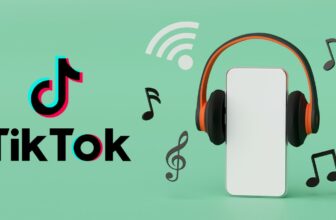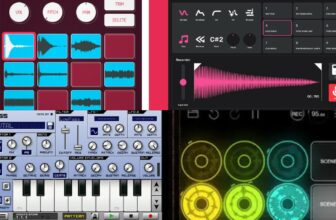The 7 Best Chord Identifier Websites and Apps (2024)

Chord Identifier Websites and Apps can be very useful for musicians when arranging or learning new songs. Even with an experienced ear and a good knowledge of music theory, identifying exact chords can take some time. Using an app or website instead can save much-needed time and energy.
Every chord identifier has its unique advantages, and you may prefer to use a handful of them while you compose, arrange, or play. To give you a brief overview of the best ones online, I’ve compiled a list of the 7 best chord identifier websites and apps. These are all free, but some offer premium features at a cost.
Contents
1. Chord Tracker
Get it on: Google Play | App Store (Apple)
Chord Tracker is a great app for identifying chords and can come in handy when you’re arranging or learning a song.
After you choose an audio file, the app will name all the chords and show the BPM as well. You can view the chord in staff notation, see the notes that make up the chord on the keyboard, or get the chord diagram for the guitar.
You can select a certain section of the audio to loop and you can even edit the arrangement by picking from other similar chords that the app recommends.
Additionally, you can alter the tempo of the track and change the key as per your preference. Say you’re trying to play a guitar and vocals cover of a song that is too high for your vocal range. You can easily transpose it down a few semitones and get the exact chords you’ll need for your transposed version.
Lastly, you can even connect a supported instrument to your device, and record the chords you want the app to identify.
2. Chordify
Go to website: Chordify
Chordify is a powerful website you can use to identify and recognize chords. You can pick any song and the site will show you the chords with the guitar, piano, and ukulele representations as the song plays.
You can adjust the tempo of the track, transpose it, and loop any segment you want to. You can even download the pdf of the chord sheet and print it.
The site allows you to play the identified chords along with the track, so you can make sure you have the correct chords. You can even change the chord and its timing to see how it sounds. This tool is especially helpful if you want to experiment with different chord progressions or arrange a track differently.
To access some features, like uploading your own music file, you’ll have to get a premium subscription.
3. MyChord
Get it on: Google Play | App Store (Apple)
MyChord is a functional app that also offers a smooth user experience. You can pick any downloaded audio file, and within seconds the app will lay out the chords of the entire track.
The accuracy is pretty high, and MyChord is great at catching quick chord changes and identifying obscure chords correctly. The app also has a recording feature that allows users to directly record the songs or audio files they want to analyze.
Additionally, it also shows the chord charts and diagrams for instruments like guitar, ukulele, banjo, and mandolin. If you want to be able to quickly play a cover on any of these instruments, the app makes the process quick and seamless.
4. Chordid
Go to website: Chordid
Chordid is a great site for musicians, composers, and arrangers. Although it does not identify chords from an audio file, it helps you identify chords by entering a few notes, or selecting keys or frets on a keyboard or fretboard interface respectively.
It’s usually not too difficult to determine at least one or two notes of a chord or segment of a track. You can enter these notes, and then explore all possible chords that contain them. You can then play them one by one and experiment to see which one fits best.
Not only is this useful for arranging or for learning covers, but it’s also useful when you’re composing. If you think of a melody first and then want to add harmony, you can use this website to play around and experiment with different chord progressions.
Its capo feature allows you to place the capo on any fret, and get the chord diagrams accordingly. You can use this to find alternative ways to play a difficult progression on the guitar.
5. Chord AI
Get it on: Google Play | App Store (Apple)
Chord AI is an app that uses advanced artificial intelligence and machine learning techniques to identify chords. Not only does it identify the primary chord, but it can also tell you the inversion and octave in which it is being played.
You can use downloaded audio files, music from YouTube and other streaming platforms, or record any music playing around you. You can loop sections, transpose the key and adjust the tempo.
The app shows you the chord charts for the guitar and ukulele, as well as piano chords. Unlike most other apps, it also shows you multiple possible ways to play the chord on the guitar and ukulele. If you are hesitant to play barre chords on the guitar, for instance, you can quickly find an easier open chord alternative.
The app offers the basic features for free, but for recognizing rare chord types, inversions, and so on, you’ll have to upgrade to the Pro version with a one-time purchase.
6. Chord Analyser
Get it on: Google Play
The Chord Analyser app is a great asset for music theory enthusiasts. This app does not analyze chords from audio files, but it allows you to select keys or frets on a keyboard/guitar interface and then gives the chord, the staff notation, and multiple different ways to play it.
This app boasts of a powerful chord dictionary, you can view all possible inversions and notations of a chord. You can explore the chord types and chord quality, and play them on the app.
This app is especially useful if you’re learning music theory. You can practice your skills and train your ear even when you don’t have access to an instrument.
The full, paid version comes with a lot of great features and unlocks a lot more instruments. There is also a combined guitar and keyboard interface, you can select notes on the keyboard and the app will tell you how to play the chord on the guitar, and vice versa.
7. Oolimo
Go to website: Oolimo
The Oolimo website has a brilliant and aesthetic user interface and very thoughtful, intricate features. It can be considered a one-stop-shop to learn about chords, progressions, and harmony.
The site is primarily for guitarists and has a fretboard interface with options to switch between left and right-handed views.
It lists all the notes of the chromatic scale, and sixty different chord types for each. You can see the multiple different ways to play any of these chords on the guitar. You can experiment with inversions, and also choose to see the note numbers and intervals.
Oolimo has a section where you learn the theory about chord progressions and harmonies from scratch. It also has advanced features like the chord progression matrix that composers and musicians with a strong base in music theory can use.
Oolimo is more like a playground for music lovers, with features that need to be explored, discovered, and enjoyed at your own pace.
What is a Chord Identifier?
Chord identifiers are websites or apps that either analyze audio files and recognize the chords in them or suggest possible chords based on notes the user enters manually. They are useful tools to have for composers, arrangers, and performers.
How does a Chord Identifier Work?
The process of identifying chords from an audio file and giving a time-aligned sequence of chords comes under a research topic called Automatic Chord Estimation. The most accurate technologies to estimate chords are based on machine learning and pattern recognition techniques and algorithms.
What are Alternatives to these Websites and Apps?
A simple way to recognize chords without using a chord identifier website or app is to look for sheet music, guitar tablature, or tutorials for the song online. These will be easily available for popular, mainstream music.
You can use sites and apps like Ultimate Guitar for a larger collection of songs. Be careful about the chord charts and capo position if you’re not a guitarist. If the arrangement is using a capo on any fret, the chord and chord shape it shows will be different from the actual chord used in the song.
How to take Advantage of Chord Identifiers?
Chord identifiers are great to use when you’re learning to play a cover, or when you’re composing and arranging. Music theory is a vast field, and it’s often easy to fall into repetitive patterns. Use chord identifiers with chord and melody generators for a more efficient composing and arranging workflow.
Limitations of Chord Identifier Websites
Chord identifier websites, while convenient, do possess inherent limitations that may affect their accuracy. Primarily, these tools rely on algorithms that, despite their sophistication, may not be capable of discerning subtle nuances or contextual clues within a piece of music.
Consequently, they may misinterpret or fail to recognize certain chords, especially if the composition involves complex structures, inversions, or uncommon chord progressions.
Additionally, the quality of the audio file provided can significantly impact the results, as poor quality or background noise may hinder the algorithm’s ability to accurately analyze the chords. Despite these drawbacks, chord identifier websites can serve as a valuable starting point for individuals seeking to understand the underlying structure of a musical piece.
Conclusion
Chord Identifier websites and apps are potent tools for musicians, irrespective of whether they are arrangers, songwriters, producers, or performers. The technologies used to identify and recognize chords are constantly evolving, and the development of more intricate artificial intelligence techniques will keep making chord recognition more powerful and accurate.
These sites and apps are in no way a perfect substitute for skill, knowledge, and musical experience. But, they can help save time and energy that is better saved for the million other things musicians, and human beings in general, have to do.






